Straight bar dips
Straight bar dips are another challenging and worthwhile variation. As the nameimplies, the straight bar dip is performed with both hands on a single straight bar positioned
in front of the body. When you do a parallel bar dip, you dip in between the bars,
but when you dip on a straight bar, your body must move around the bar. As you lower
yourself down, you’ll need to reach your legs out in front a bit to keep balance.
The straight bar dip is one of the more challenging dip variations and one of the most specific
precursors to the muscle-up. You should start working on these once you can do a few reps
on the parallel bars.
The straight bar dip is one of the more challenging dip variations and one of the most
specific precursors to themuscle-up.
Perpendicular Bar Dips
You can also split the difference between the parallel bars and the straight bar by practicingyour dips on two perpendicular bars. Feel free to get creative with everyday scenarios
if you don’t have access to formal workout equipment.
Dips on the perpendicular bars and parallel bars are very similar, though they each
have their own nuances. Just like with parallel bars, playing around with how far forward
you lean can effect the subtleties of muscle recruitment. Lean forward for more
chest, stay upright for more triceps and abs. The perpendicular bar set-up can allow you
to stay more upright without the potential shoulder strain. Just make sure you are strong
enough to handle this variation before you start trying to rep out.
Korean Dips
A Korean dip is a behind the back dip on a high bar. It’s almost like the low bar dip Italked about earlier, except your feet are in the air!
This is one of the hardest dip variations, so I suggest getting very comfortable with the
others before attempting the Korean dip. You should be able to perform at least fifteen
consecutive parallel or perpendicular bar dips first. Because it is difficult to control your
body from this angle, you’ll really need to focus on engaging your abs and lower back
muscles to stabilize. It also helps to keep your hamstrings and glutes contracted. Having
the bar behind you can give your shoulders a deep stretch as well, so make sure you are
warmed up. The Korean dip is really a full body exercise.Here is video tutorial for additional
help.





















